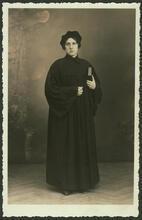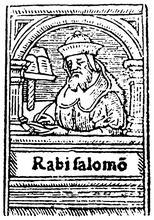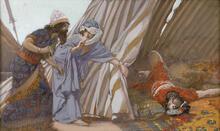Ishah Hashuvah (Woman of Distinction)
The Hebrew term ishah hashuvah appears in seven sugyot (Talmudic discourses) in the Babylonian Talmud, though its meaning is not clear. It seems to refer to a woman of some wealth or importance. The Talmud references the isha hashuvah in the context of debates around wearing expensive ornaments on Shabbat, leaning at the Seder table, financial payments for divorce, and social relationships between Jews and Gentiles.
The Hebrew term ishah hashuvah appears in seven Talmudic discoursesugyot (Talmudic discourses) in the The discussions and elaborations by the amora'im of Babylon on the Mishnah between early 3rd and late 5th c. C.E.; it is the foundation of Jewish Law and has halakhic supremacy over the Jerusalem Talmud.Babylonian Talmud but never appears in the The interpretations and elaborations of the Mishnah by the amora'im in the academies of Erez Israel. Editing completed c. 500 C.E.Jerusalem Talmud. The term is not defined, though in a few instances its meaning is evident from the context.
City of Gold
The sixth chapter of Codification of basic Jewish Oral Law; edited and arranged by R. Judah ha-Nasi c. 200 C.E.Mishnah SabbathShabbat lists items that women and men are permitted to wear outside their homes on the Sabbath without violating the prohibition of carrying from the private to the public domain. It also lists other items that must not be worn for fear of violating the prohibition, though if a person went out wearing them, he or she is not liable to bring a sin-offering. One of the ornaments mentioned in the first Mishnah is a “city of gold.” In BT Shabbat 59a and 59b, the “city of gold” is identified with the “Jerusalem of gold” which Rabbi Akiva made for his wife. Later a Lit. (Aramaic) "outside." Halakhah and aggadah from the tanna'ic period that was not included in Judah ha-Nasi's Mishnah.baraita appears which has a parallel in the (Aramaic) A work containing a collection of tanna'itic beraitot, organized into a series of tractates each of which parallels a tractate of the Mishnah.Tosefta, listing three opinions on appearing in public wearing this ornament. Rabbi Meir rules that a woman may not do so wearing a “city of gold” and is liable if she does, based on the assumption that wearing a “city of gold” is tantamount to carrying a burden on the Sabbath. The sages were of the opinion that a “city of gold” was an ornament and forbade women to wear it on the Sabbath lest they take off the diadem to show their friends, inadvertently carrying it more than four ammot (1.75 meters) in the public domain. The sages’ position is the one given in the Mishnah. Yet in the opinion of Rabbi Eliezer, going out wearing a “city of gold” is permissible a priori, since only an ishah hashuvah is accustomed to going out wearing this ornament and there is no fear that an ishah hashuvah will remove it from her head. The term “distinguished woman” appears here as an anonymous Talmudic statement. In this particular context, it seems to refer to a woman of a high socio-economic class, given the costliness of such an ornament.
Kelila
The term ishah hashuvah also appears later in the Talmudic sugya in a discussion concerning the kelila, a kind of tiara, an ornament not mentioned in the sixth chapter of Mishnah Shabbat. The Lit. "teaching," "study," or "learning." A compilation of the commentary and discussions of the amora'im on the Mishnah. When not specified, "Talmud" refers to the Babylonian Talmud.Talmud notes that according to Rav a woman should not go out wearing a kelila on the Sabbath, but according to Shmuel it is permitted. An anonymous statement in the Talmud clarifies the opinion of Rav Ashi that both Rav and Shmuel allow women to appear in public wearing a kelila de-arukta, a diadem engraved with a band of gold and precious stones (Rashi), though they disagree regarding a kelila de-aniska, a diadem of metal. Rav prohibits it for fear that the woman might remove it to show it and possibly come to carry it, while Shmuel permits it, opining that only an ishah hashuvah would appear wearing a kelila de-aniska and such a woman does not remove it to show it off. As in the discussion concerning the “city of gold,” here, too, the term ishah hashuvah is not attributed to a specific sage but appears as an anonymous statement. The meaning of the term “important woman” here is similar to that in the sugya concerning the “city of gold.”
At the Seder Table
Mishnah A seven-day festival to commemorate the Exodus from Egypt (eight days outside Israel) beginning on the 15th day of the Hebrew month of Nissan. Also called the "Festival of Mazzot"; the "Festival of Spring"; Pesah.Pesahim 10:1 rules: “Even the poorest in Israel must not eat unless he sits down to table.” The Talmudic discourse on this ruling in Pesahim 108a lists the foods at the Passover meal that require reclining: unleavened bread, bitter herbs and wine. The text goes on to discuss whether lying on one’s back or leaning to the right side are considered reclining. There then appears a discussion on which people are required to recline: a woman in the presence of her husband; a son in that of his father; a student in the presence of his teacher, and a servant. Regarding women, the Talmud rules: “A woman in the presence of her husband (lit. by her husband) does not need to recline, but if she is an ishah hashuvah she is required to recline.” However, several textual variants do not include the phrase “by her husband.” Thus the term “ishah hashuvah” appears here, too, as part of an anonymous statement.
The meaning of the term is not given, nor is it completely clear from the context of the discussion. The Rashbam (Samuel ben Meir, c. 1080–c. 1174) cites a reason for exempting an ordinary woman from reclining due to her fear of her husband and her subordination to him. Avraham Grossman points out that the fact that the sages obligated an ishah hashuvah to recline, indeed supports the opinion that the exemption arose from a woman’s subordination to her husband. In the literature of the Rabbinic authorities/halakhic decisors/ biblical commentators of the mid-11th to mid-15th c.. The period of the rishonim followed that of the geonim and preceded that of the aharonim.Rishonim the term ishah hashuvah relates to the historical reality in various communities. Jewish sages in Islamic countries and in Christian Spain dealt only marginally with the term, while the sages of Ashkenaz and France dealt with it a great deal. Talmudic commentators and The legal corpus of Jewish laws and observances as prescribed in the Torah and interpreted by rabbinic authorities, beginning with those of the Mishnah and Talmud.halakhic decisors in Germany, France and Provence were acquainted with many contemporary women who played an important economic role, and it was difficult to perceive them as being fearful of their husbands. Many of the Tosafists ruled that all the women in their communities were considered important and therefore obligated to recline.
Another mention of the term appears in BT Pesahim 110b in a discussion of the prohibition on "pairs" (eating and drinking two or a multiple of two of any thing can cause one to be harmed by demons or evil spirits). The Talmud states: "A woman is not subject to even numbers; but if she is an important woman, we take heed." Here too ishah hashuvah appears in an anonymous statement in the Lit. "teaching," "study," or "learning." A compilation of the commentary and discussions of the amora'im on the Mishnah. When not specified, "Talmud" refers to the Babylonian Talmud.Gemara.
The Ketubah
In BT Marriage document (in Aramaic) dictating husband's personal and financial obligations to his wife.Ketubbot 71b, the term ishah hashuvah appears in the name of Rava (R. Abba b. Joseph b. Hama, d. 352) in the discussion on Mishnah Ketubbot 7:3, which concerns a man who vows to abstain from his wife if she ornaments herself: “If a man makes a vow forbidding his wife to adorn herself with a particular kind of ornament, he must grant her a divorce and pay her her ketubbah. R. Jose says: [This applies to] poor women if he enjoined no set time, and to rich women [if the vow was for] thirty days.” Abaye explains the law that a man is obligated to divorce his wealthy wife after thirty days, stating that is the length of time that a distinguished woman enjoys the scent of the ornaments she wore previously. There is a certain parallel between the concept of “wealthy women” in the Mishnah and that of Abaye’s ishah hashuvah, and in this context an ishah hashuvah means a wealthy woman.
The term ishah hashuvah which appears in BT Ketubbot 75a relates to the first part of Mishnah Ketubbot 7:7: “If a man betrothed a woman on the condition that she was under no vow and she was found to be under a vow, her betrothal is not valid.” During the ensuing discussion, the term ishah hashuvah is mentioned in Rava’s name concerning a baraita which states that a woman who went to a sage who released her from her vow is not betrothed. In the case of an ishah hashuvah, the husband prefers that the marriage be considered invalid a priori since then, if he gives her a get, he will be forbidden to marry her relations, her mother or sister, and he would like the option of marriage to other female members of her family to remain open to him. The use of the term ishah hashuvah in this context means that she comes from a respected family, a “daughter of noble people” in Rashi’s words.
Avodah Zarah
In BT Avodah Zarah 25a and 25b, the term ishah hashuvah appears in a discussion of reasons to forbid a Jewish woman from secluding herself with a non-Jewish man. Mishnah Avodah Zarah 2:1 rules that a woman may not seclude herself with non-Jews because they are to be suspected of illicit sexual behavior, and that a man may not seclude himself with them because they are suspected of bloodshed. The Talmud discusses the possibility that a Jewish woman must likewise be forbidden from secluding herself with a non-Jewish man because of the suspicion of bloodshed. In this context two opinions are cited: “R. Jeremiah said: We are here dealing with a woman of high repute, so that he would be afraid of her. R. Idi replied: A woman bears her weapons upon her.” The Talmud therefore regards an ishah hashuvah as one who inspires fear, though the nature of her distinction is not mentioned. In the opinion of the Rashbam, an ishah hashuvah is a beautiful woman who has connections with the monarch. Further in the discussion, the question arises as to the difference between the two opinions and the text makes the following distinction: “There may be an ishah hashuvah among men who is not hashuvah among women.” R. Jeremiah is of the opinion that such a woman is in danger of neither sexual assault nor murder, while R. Idi believes that for all women there is a potential for licentious behavior.
An investigation of the term ishah hashuvah shows that in three of the discussions the term is referred to by specific amoraim: Abaye, Rava and R. Jeremiah, their contemporary. However, in the rest of its appearances throughout the Babylonian Talmud, the term is mentioned only anonymously. One cannot discern any one all-inclusive definition of this articulation. The ishah hashuvah of Ketubbot 71b is clearly a wealthy woman, while the one mentioned in Shabbat belongs to the upper economic classes and the one of Ketubbot 75a comes from a respected family. The discussion in Pesahim concerning the reclining of women has been referred to and commented upon extensively in the rabbinic and halakhic literature, due to its practical application in the Lit. "order." The regimen of rituals, songs and textual readings performed in a specific order on the first two nights (in Israel, on the first night) of Passover.seder ritual.
Hebrew
Bigman, David. “Are Our Wives ‘Distinguished Women’?” Bikkurim 3 (1986): 49–51.
Bar-Ilan, Meir. “A Woman Bears Her Weapons Upon Her.” Studies in Jewish Folklore 16 (1994): 29–40.
Grossman, Avraham. Pious and Rebellious: Jewish Women in Europe in the Middle Ages. Jerusalem: 2001, 326–328.
Gertner, Yaakov. “Leaning at the Passover Seder: Sephardic Women Compared with Ashkenazic Women.” Sha’anan 8 (2002): 141–146.
ha-Cohen, Aviad. “Are Women Lazy?! Women Are Distinguished!” Alon Shevut 11 (1998): 63–82.
Levine Katz, Yael. “Jerusalem of Gold.” Mehqere Hag: A Journal of Jewish Culture 12 (2001): 116–140.
English
Shakdiel, Leah. “We Can’t Be Free Until All Women Are Distinguished.” In The Women’s Passover Companion: Women’s Reflections on the Festival of Freedom, edited by Sharon Cohen Anisfeld, Tara Mohr and Catherine Spector, 54–58. Woodstock, Vermont: 2003.








